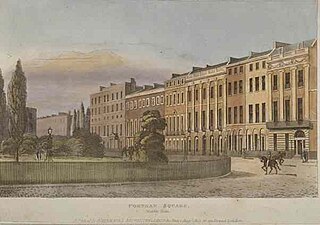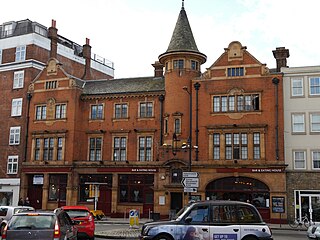
Borough Market is a wholesale and retail market hall in Southwark, London, England. It is one of the largest and oldest food markets in London, with a market on the site dating back to at least the 12th century. The present buildings were built in the 1850s, and today the market mainly sells speciality foods to the general public.

Mount Street Gardens is a public garden off Mount Street in the west of the Mayfair area of London, England. The gardens were created in 1889 out of a former burial ground of St George's, Hanover Square, and named after the Mount Field, an area including a fortification dating from the English Civil War named Oliver's Mount.

Richmond Green is a recreation area near the centre of Richmond, a town of about 20,000 inhabitants situated in south-west London. Owned by the Crown Estate, it is leased to the London Borough of Richmond upon Thames. The Green, which has been described as "one of the most beautiful urban greens surviving anywhere in England", is roughly square in shape and its open grassland, framed with broadleaf trees, extends to roughly twelve acres. On the north-east side there is also a smaller open space called Little Green. Richmond Green and Little Green are overlooked by a mixture of period townhouses, historic buildings and municipal and commercial establishments including the Richmond Lending Library and Richmond Theatre.

St Lawrence Jewry next Guildhall is a Church of England guild church in the City of London on Gresham Street, next to the Guildhall. It was destroyed in the Great Fire of London in 1666, and rebuilt to the designs of Sir Christopher Wren. It is the official church of the Lord Mayor of London.

Prince Henry's Room is situated on the first floor at the front of No. 17 Fleet Street, London. The house is one of the few surviving buildings in the City of London dating from before the Great Fire of London in 1666. It is a Grade II* listed building.

Great Tower Street, originally known just as Tower Street, is a street in the City of London, the historic nucleus and modern financial centre of London, England. It forms an eastern continuation of Eastcheap starting at Idol Lane, and leads towards Byward Street and Tower Hill. On Byward Street, opposite Great Tower Street, is the historic church All Hallows-by-the-Tower.

Portman Square is a garden square in Marylebone, central London, surrounded by townhouses. It was specifically for private housing let on long leases having a ground rent by the Portman Estate, which owns the private communal gardens. It marks the western end of Wigmore Street, which connects it to Cavendish Square to the east.

Lamb's Conduit Street is a street in Holborn in the West End of London. The street takes its name from Lambs Conduit, originally known as the Holborn Conduit, a dam across a tributary of the River Fleet.

The King's Head is a Grade II listed public house at 4 Fulham High Street, Fulham, London.

The Wheatsheaf is a public house at 6 Stoney Street, Borough, Southwark, London. Established in the 18th century, it has become a prominent landmark and a popular drinking establishment in the area, known for its rich history and traditional pub atmosphere.

The Sun and 13 Cantons is a Grade II listed public house at 20 Great Pulteney Street, Soho, London W1.

The Baroness Burdett Coutts Drinking Fountain is a Grade II* listed drinking fountain situated in Victoria Park, London.

The Matilda Fountain is a Grade II listed statue and drinking fountain opposite 15 Gloucester Gate, Regent's Park, London, built in about 1878.

The Ship and Shovell is a Victorian pub in Craven Passage, Charing Cross, London. It may be unique for consisting of two separate buildings on either side of a street, connected underground by a shared cellar.

The Guilford Place drinking fountain is a Grade II listed drinking fountain at Guilford Place, London WC1, built in about 1870, and designed by the architect Henry Darbishire, for the Misses Whiting to commemorate their mother.

The Guilford Place public conveniences are Grade II listed former public toilets at Guilford Place, central London, built in the late 19th century.

Guilford Place is a Grade II listed Georgian terrace of four houses in Guilford Place, London WC1, built in about 1791 to 1793 by J. Tomes and W. Harrison.

The Drinking Fountain is a Grade II-listed monument at Roehampton Lane, Roehampton, London SW15.

The Readymoney Drinking Fountain, also occasionally known as the Parsee Fountain, is a Grade II listed structure near the middle of the Broad Walk footpath on the east side of Regent's Park, in London. It lies southeast of London Zoo, close to the highest point of Regent's Park, about 41 metres (135 ft) above sea level, in an area with few trees, making it widely visible across the park.




















